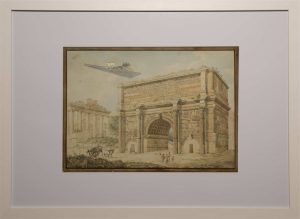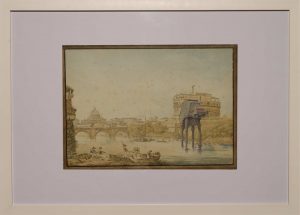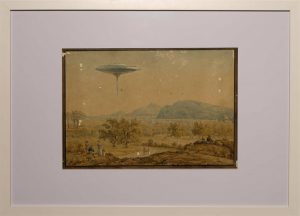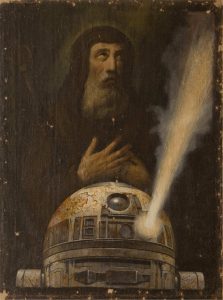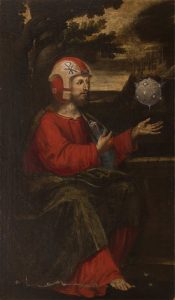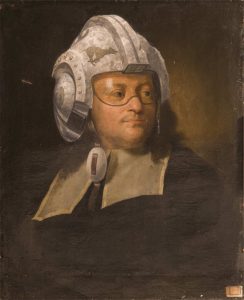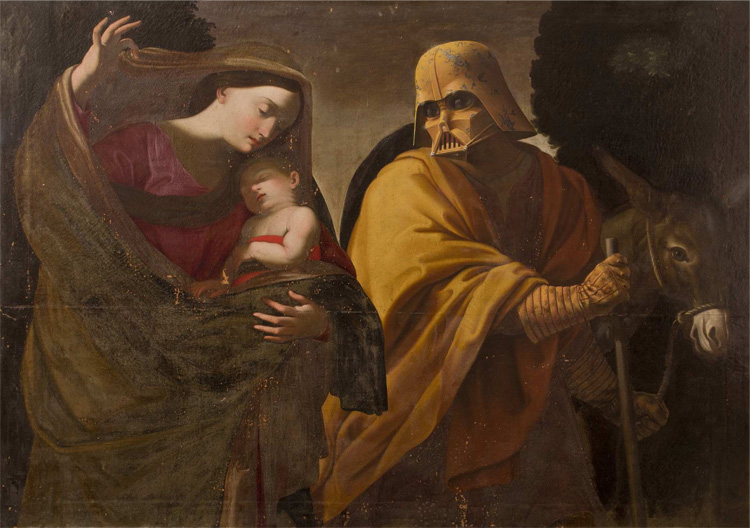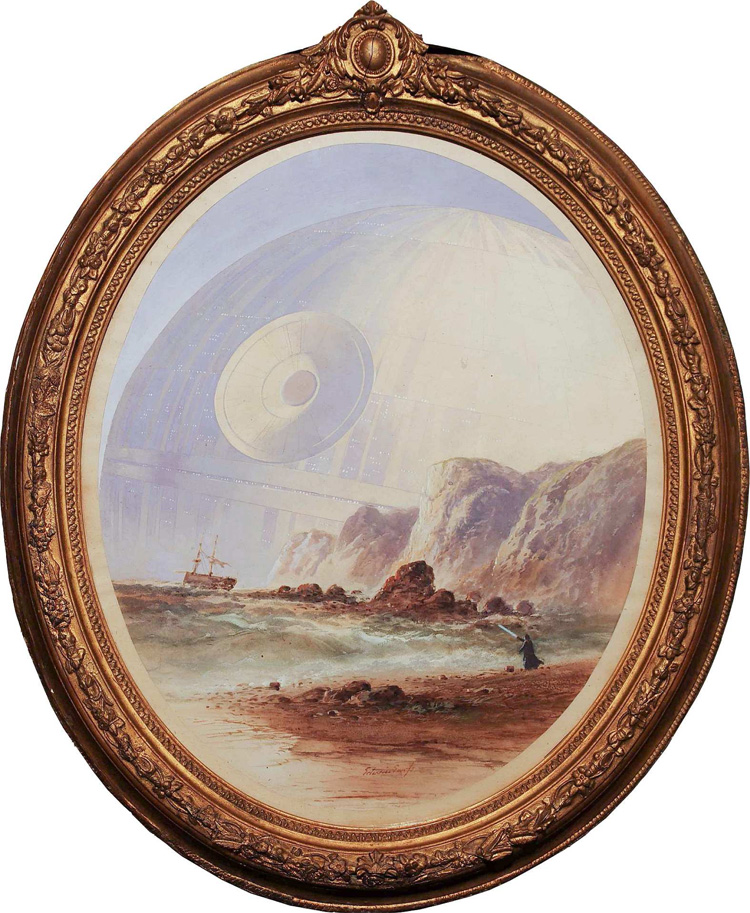01 Dec Religious Paintings of the Expanded Galaxy
Riccardo Mayr:
Religious Paintings of the Expanded Galaxy
(A 17th Century Star Wars Mash-up)
December 2017 – January 28, 2018
An inspiration from the past,
an unexpected twist in our present,
a proof for future generations.
The purpose of this project is to integrate into original paintings from the 17th and 18th Century fictitious elements and characters taken from the popular culture of our times: the Star Wars saga. In so doing, we present religious faith and ethics in a post-modern paradigm largely embedded in fictional reality through a multi-generational exposure and fascination with successful science fiction movies. We also give back to figurative oil paintings a new path to a concept of truth.
In most cases, the original paintings had sustained damage over centuries of non-archival storage with the cost of restoration exceeding their relative value, so more than just a mash-up of classical works from antiquity with contemporary pop, there is an element of art preservation and new relevance. Such methods can be understandably controversial, but Robert Rauschenberg‘s erasing of Willem de Kooning‘s drawings helped set a modern precedent by which an artist’s alteration can be transformative.
Franz Kaisermann,
Swiss 1765 – 1833
Three views of Rome in white wood frame with glass. Etchings with hand coloring, with dark brown framing lines, inscribed in brown ink lower left.
-
Riccardo Mayr
Arc of Constantine and Star Destroyer
After Franz Kaisermann, 1765-1833
Etchings with hand coloring, 297×422 mm. (11 3/4 x 16 5/8 in.) $7,000.
-
Riccardo Mayr
Castle St. Angelo with Imperial AT-AT Walker
After Franz Kaisermann, 1765-1833
Etchings with hand coloring, signed in brown ink, lower right “Franz Kaisermann” 297×422 mm. (11 3/4 x 16 5/8 in.) $7,500.
-
Riccardo Mayr
Neoclassical Landscape with Cloud City
After Franz Kaisermann, 1765-1833
Etchings with hand coloring, 297×422 mm. (11 3/4 x 16 5/8 in.) $7,000.
Ferrarese School,
Italy 14th – 18th Century
The School of Ferrara was a group of painters which flourished in the Duchy of Ferrara during the Renaissance. The school evolved styles of painting that were appeared to blend influences from Mantua, Venice, Lombardy, Bologna, and Florence. The ties to Bolognese School were particularly strong. In the late 15th century Ferrara was also a main centre of engraving in Italy.
-
Riccardo Mayr
The Long Lost Hologram Message
Ferrarese School, 17th Century
St. Francis of Paola
Oil on canvas, 80×65 cm. (31 x 25 in.) $15,000.
-
Riccardo Mayr
Remote Training at Sichar’s Well
Ferrarese School, 16th Century
Christ at the Well
Oil on canvas, 177×102 cm. (69 x 40 in.) $30,000.
-
Riccardo Mayr
Manchild
Ferrarese School, 18th Century
Portrait of a Man
Oil on canvas, 70×60 cm. (27 x 23 in.) $15,000.
-
Riccardo Mayr
Escape From Gliese 832c
After Guido Reni, 17th century
(The Escape to Egypt)
Oil on canvas, 125x175cm (49×68 in.)
ABOUT THE EXHIBITION:
Riccardo Mayr was born and raised in Ferrara, Italy, a small city, which carries in its streets and buildings the marks of a glorious past.
During the sixteenth century, the cities of the Emilia-Romagna were vibrant and quite distinctive, artistically and culturally while small in population. The three principal centers, Ferrara, Bologna, and Parma, were especially so, and each had a unique trajectory in both politics and the arts. Ferrara was home to one of the most important humanist courts in the Renaissance, which is known as the Este dukes. Ferrara was a crucible of Renaissance thought and art. Throughout the fifteenth century, its rulers, the Este family, commissioned works from the greatest contemporary painters, including Giovanni Bellini, Fra Bartolommeo, Raphael, Titian, and Dosso Dossi.
Riccardo grew up in an early Baroque palazzo located in the center of the city. The palazzo is over 500 years old, and has belonged to the Mayr family for more than 200 years.
This castle-of-sorts with a stately court yard garden is a real time capsule, hosting collection of paintings that spans 500 years, assembled by Riccardo’s ancestors. The objects of art, pieces of ancient furniture and family memorabilia ranging from the XVI to the XX Century are a tangible testimony of ancient times, peoples and events. Living in the palazzo, surrounded by such tangible testimony of ancient times, Mayr grew up deeply affected by the sense of passing time, by century of accumulation of dust, and by the colors and smells of time.
Riccardo’s mother who had been the matriarch of the Mayr family and palazzo died recently, requiring that Riccardo and his sister manage the affairs of the Mayr estate–including the collection of paintings put together by their ancestors during the last 200 years. It would be a daunting task for any husband and father, but even more so when considering the massive collection of priceless antiquities in the Mayr estate.
As Riccardo pondered the massive responsibility, he paced the palazzo, turning his sight to the walls around him, rows of ancient paintings, testimony of an unquestionable pastime, events, landscapes, and mute portraits of ancestors staring ever back at him. He began thinking about the sense of sacrifice inherent in the religious paintings of the family collection, which is similar to any parent’s sacrifice on behalf of their children; religious themes, ancient beliefs and offerings for relief.
At one point, Riccardo reminisced about his childhood, running through the sequence of Baroque rooms of the palazzo playing for what seemed like endless games of hide and seek, impersonating characters of the first Star Wars movies, of good versus evil, the bad and the good chasing each other with cardboard light sabers. He thought about his son, now 11 years old who has become his own Star Wars enthusiast, playing like Riccardo would in the same palazzo 35 years earlier in what seems to be the atemporal playground of the Mayr family house and garden. And so Riccrado connected the dots between his past and present, between the centuries old, visual art traditions of Ferrara and the cinematic culture we are embedded with cross-culturally, today. Riccardo realized there are links between the religious art of the family paintings and the commercial art of the Star Wars saga; both addressing the meaning of sacrifice on behalf of others, redemption and the human need for repentance.
Therein lives the genesis of what is unveiled in this painting project, Religious Paintings of the Expanded Galaxy. Riccardo commissioned the Ferrara painter who had taught his mother and together they created a new technique which integrates directly onto original paintings from the 17th and 18th Century the characters and machines of the Star Wars saga.
-
Riccardo Mayr
Unreasonable Threat of a Contemplative
English School, 18th Century
Marine with Shipwreck
Watercolor on paper in original wood frame with glass, 40×30 cm. (15 x 11 in.)
$10,000
Sold
Riccardo Mayr (born 1970) in Ferrara is an Italian architect, self-taught painter and art enthusiast at large.
From the very beginning of his art studies in the 1990s, he focused his attention on painting with uncommon materials such as rust, charcoal, ash, lead, iron and mirror debris–primarily in an effort to question the meaning of authorship within the act of creation, itself.
The subjects of his paintings, while remaining in the domain of classical landscapes and portraits, are a blend of the pure act of painting and art performance, which has, in view of the massive use of new technologies, become questionable.
Emanuele Taglietti (born 1943) in Ferrara is an Italian illustrator, mostly known for his covers for digest-sized, adult fumetti (comics themed around sex, violence, and horror). By the end of the 1980s Taglietti started to work as an oil painter, teaching decor and the conservation of murals. In 2000, he retired from teaching, but continued to work as muralist and watercolor painter. Riccardo and Emanuele have know each other for 20 years, but two years ago decided to collaborate for this exhibition, Religious Paintings of the Expanded Galaxy.
These are artifacts renewed.
Purchase Inquiries
Matt Kennedy
Gallery Director
323 547 3227
info@gallery30south.com

